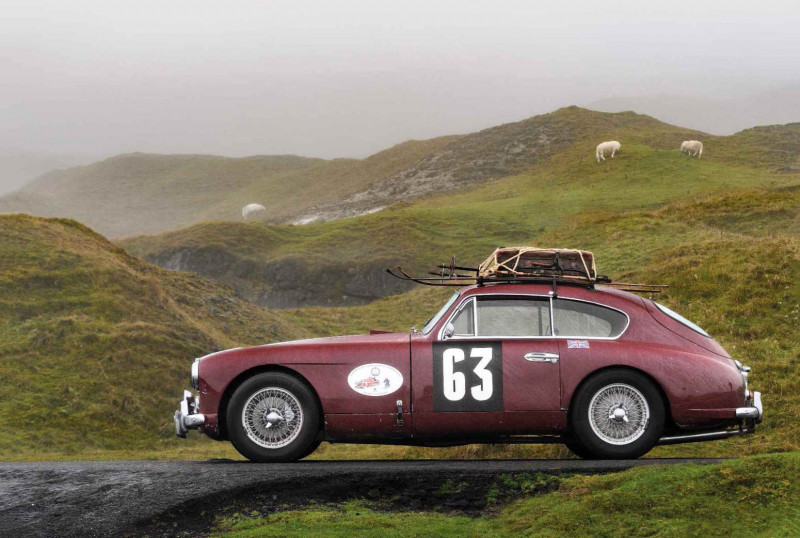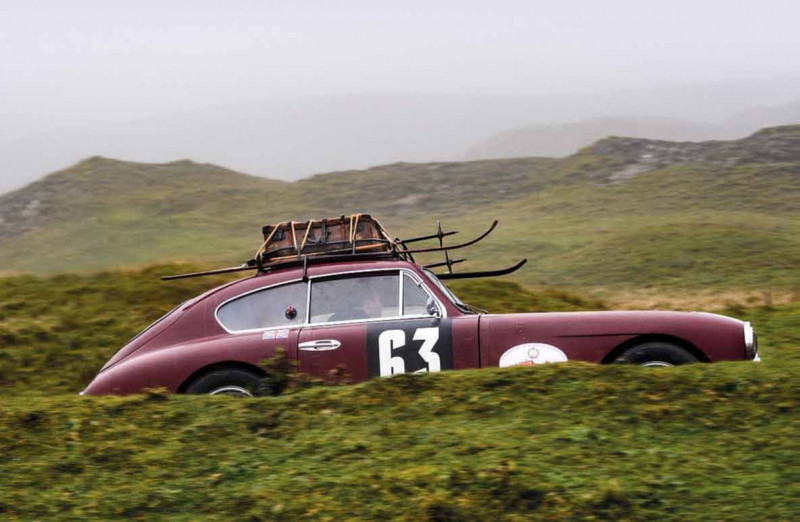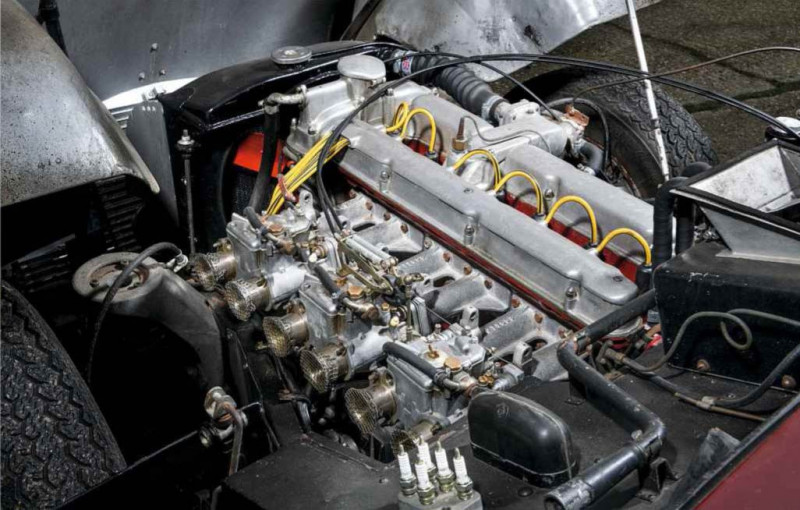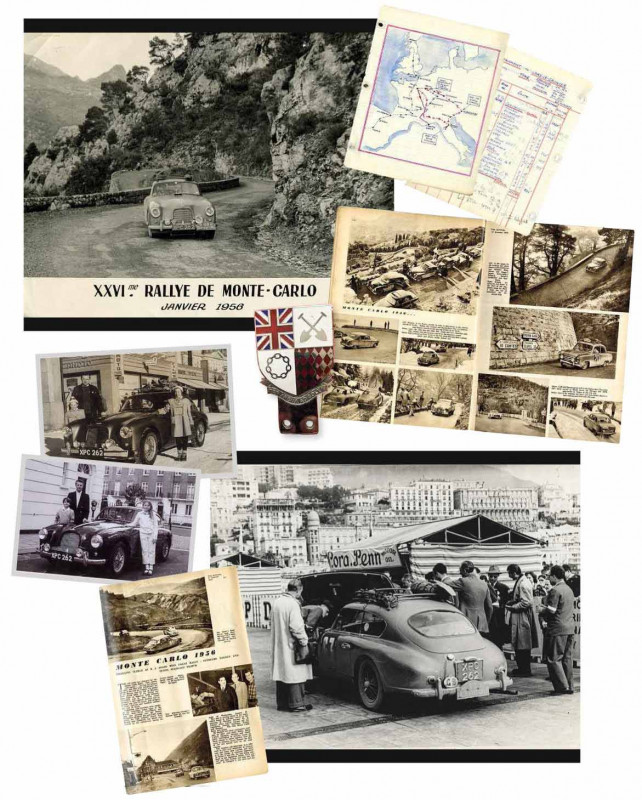26th Monte Carlo Rally 1956 Aston Martin DB2/4
This Aston Martin DB2/4's Monte Carlo Rally history was deliberately buried. Decades on it was revived by the original owner's son. Words James Elliott. Photography Tim Scott.
LOST AND FOUND MONTE CARLO RALLY ASTON DB2/4
LOST MONTE-GARLO ASTON Heroic DB2/4 emerges from obscurity
The 26th Monte Carlo Rally in 1956 was typical of the era, when a hefty saloon was as likely to come home first as a speedy lightweight, the results read like a mish-mash of a backstreet dealer’s forecourt, no theme or rhyme or reason emerging, the first model of which two appeared in the results was a Panhard Dyna Z 850, some distance behind the winning MkVII Jaguar of Ronnie Adams, Derek Johnston and Frank Biggar. The top three was rounded out by a Mercedes-Benz 220A and a DKW 898. Most exotic car in the top ten was probably the BMW 502, or maybe the Citroen DS19. While Autosport editor Gregor Grant tackled it in his MG Magnette, the most rarefied car in the rally was a 300SL, yet the drivers’ roster was brimful of stars such as Pat Moss, Sheila Van Damme, Ken Wharton and Archie Scott Brown; even Louis Chiron and more of that calibre.

The 141st car to finish of the 308 entrants was this one, the privateer entry for Ken Carter and Robert Ropner being one of 73 British starters, There was a lengthened route with all-fresh start points in 1956 and, while most Brits headed to Glasgow, this pair drove to Paris for the off. It wasn’t entirely the plucky amateur effort that it looked on the surface, Carter having spent a week prior to the rally practising on ice and snow in the Swiss Alps and picking the Paris start because the timing ensured that all the trickiest driving would take place in daylight hours. Still, the pair didn’t really trouble the scorers, as cricket folk say, though the crew merited a mention in both The Motor and The Autocar, with a picture of the Aston being the lead image in the latters delightfully detailed write-up, which also noted that Estager retired with food poisoning after a dodgy bouillabaisse and compared the scenery on the new route to a Gustav Dore painting.
'IT IS HARD TO BELIEVE THAT THE ASTON'S MONTE HISTORY WAS FORGOTTEN FOR DECADES'
When I first meet the Aston at Salon Prive, it’s sitting serenely on the manicured lawns of Blenheim Palace in a scene that’s a bit more Jack Vettriano. Just a few hours later it would clinch two prizes, People’s Choice and the prestigious Preservation award. It’s no surprise: a bespoke roofrack was constructed by Andrew Maclean, based on period photos, while the rest of the meticulous period dress, rally plates, badges and delectable patina make it look fresh back from the Gorges de la Bourne.

It is being chaperoned by specialist Dylan Miles. He tells me: ‘It’s a once in a lifetime find and I fell in love with the story and its patina the moment I laid eyes on it. When it came to light again it was hugely exciting, and it must be one of, if not the last, undiscovered Feltham car with significant competition history that is substantiated with its original documentation. Even the Aston Martin Owners’ Club was unaware of its existence.’
Seeing it decorated with skis, sticks and suitcase atop, creating the ideal picture to filter black and white, it is hard to believe that its Monte history was forgotten for decades. Likewise when carefully thumbing your way through the reams of notes that Carter and Ropner meticulously logged during the rally, the maps they drew, the notes they jotted down, the calculations they made in the margins. It is a phenomenally seductive piece of history, then there are the service notes, the most compelling entry, from 21 November 1955, listing all the pre-Monte works from decarbonising the engine to adding one Marchal and one Lucas foglamp (which turned out to be much-needed on the event) and the fitting of yellow headlamp bulbs.
The DB2/4 was clearly a fine basis for a rally car. Built from 1953 to ’1959, it was a development of the DB2, which was Aston Martin’s second new post-war model and, via the one-off Atom and super-low production 2 Litre Sports (now sometimes dubbed the DB1), marked a seachange in the company’s direction from its cycle-winged pre-war sports cars — mimicking the social mores of the time, an unshackling from the stern, starch-collared and starving immediate post-war world, finally re-embracing fun in a guilt-free yet really rather grown-up way.

There was a new grandeur to the cars, a GT comfort that would inform the way the powertrain evolved throughout the late 1940s and 1950s. At first it was the four-cylinder 2.0-litre, then the more sophisticated WO Bentley-designed chain-driven twin-cam Lagonda LB6 2.6-litre straight-six, from 1954 enlarged to a 2.9 (VB6J), driving through a four-speed David Brown ’box, natch.
Visually, the DB2/4 has a foot in each era, being built on a modified version of the cruciform Atom chassis. Frank Feeleys voluptuous aluminium body, though updated and longer for the 2/4, remains square-rigged but a world away from the age of running boards, while at the front the grille is just beginning to take on that familiar, rakish Aston shape, yet somehow also retains an upright, uptight, Amstrong-Siddeley-esque severity.
The DB2/4, its designation merely meaning the four-seater version of the DB2 (Harold Beach himself referred to its ‘lavatory’ rear seats), shared the DB2s wheelbase and only the rear chassis crossmember had to be adjusted to suit, This was the foundation of a sporting dynasty, the point at which Aston cemented its values and when David Brown’s stock really took off. Plus, though officially and incongruously called the saloon, the DB2/4 marks the birth of the sporting hatchback, but that’s your ‘Princess Anne had one’ level of info.

This example in particular would have been approved of by David Brown who, having bought the company in 1947, was a firm believer that competition improved — and sold — the breed. Indeed, the DB2 was born to race and did so successfully before it was available as a road car. Even so, with the DB2/4 the company had a commercial hit on its hands, and demand for five cars per week overwhelmed the Feltham works. David Brown bought Tickford in Newport Pagnell to make the bodies and so began another chapter in Aston history, The model’s development was traditionally glacial, but that did not mean Aston Martin would forgo the marketing value of launching a ‘new’ model. Subsequently, the Mark 2 DB2/4 was revealed in 1955, with so few changes that the company’s official publicity shot was just a retouched photo of a Mark 1. It sold in smaller numbers up until 1957, with around 200 being built.

A standard DB2/4 may not be the showiest car of the era; gone is the luxurious interior of your typical upmarket Brit, but it certainly puts in a decent performance, with sharp handling and steering and being surprisingly fleet of foot. Capable enough for the day, through the various road, competition and Vantage options, power ranged from 125 to 160bhp, with a 111mph top speed, and a 0-60mph time from just under 10sec to just over 12.
This one is different, though. In place of a pair of SUs is a trio of sucking and spitting Webers, adding some real snarl to the engine, which exhales through a twin exhaust system fitted by the works in 1956. The box is recalcitrant only due to its lack of synchro on first, and the more speed you have and more determination you put into the operation, the speedier and smoother the changes, The worm-and-roller steering is adroit and the brakes cope well with pulling it up. Whether the original Alfin drums (12in) would have been quite as efficient at arresting around 2600lb of Aston Martin after the use required by crossing the Cols du Granier and de Rousset en route to Monte-Carlo is another matter. Especially if the pedal then had as much travel before biting as it does now.
That this DB2/4 drives like a much younger car can be attributed to its ownership by Swiss dealer Christophe Grohe in 1988 and more recent work by Pugsley and Lewis in 2021. Grohe did complete a sympathetic restoration during his ownership and rebuilt the factory- fitted big-valve DB3S production spec LI head, as the works Monte entries had run in 1955 to take the team prize. He also fitted Girling front discs with servo; one of those three works cars had been similarly equipped.
It is pretty noisy inside, and it is difficult to imagine communicating over the length of the rally, though as you step straight into the driver’s seat you can appreciate that those high sills would have been a big bonus, The front seats are separate but form a bench with a toolkit in the armrest and a long, wand gearlever ahead of them. A load of money has been spent on the suspension and it shows in impeccable road manners, while you sit quite high for a relatively low car. Steering, via a three-spoke wood-rim wheel, varies between very vague and very heavy, that sweet spot coming on twisty country roads at about 50mph. But the key to this car is the throttle, principally because the nice big pedal unlocks its best feature: the additional poke afforded by those engine upgrades.

Clockwise, from left Upgraded front disc brakes and period-fitted cylinder head to ‘production’ DB3S spec, plus recent suspension rebuild make the DB2/4 superb to drive; lavish dash has anticlockwise rev-counter; hatchback offers useful rear space for rallying; beautifully patinated period details abound; WO Bentley-designed ‘six’ is now running on triple Webers; wonderful toolkit tucked away in armrest.
It is a wonderful machine, but that just makes you wonder how this rich history could have been lost. Or, more accurately, buried. Ken Carter moved it on quite quickly and retained all evidence of its sporting exploits for fear that such arduous use might lower its value. And the further it got from him, the more its history was forgotten. It moved through a couple of other British owners, including reputedly Ron Fry, before moving to Switzerland in the late 1970s and Grohe picking it up in the late 1980s. Again it was sold on and there it stayed until 2004 when, remarkably, this story went full circle and it was tracked down and bought by Ken Carter’s son, Chris Campbell-Carter.
Campbell-Carter remembers the Aston fondly from his youth. ‘My father was a 500cc Cooper racer — he won the championship in 1950 — but he did three Montes and bought the Aston just for the rally, really. I remember all the fuss about preparing it and I remember being car-sick in it a few times.
‘Before the rally we went to Switzerland in it to go skiing, and I don’t think he took it back to the UK before the event. I was only seven or eight at the time and I will never forget the effect it had on people. I was so proud that we took it skiing in Davos, and when we went into a cake shop and came back to the car we couldn’t get to it because it was surrounded by so many people: it was really quite exotic and we felt like celebrities. It was such a memorable time; we used to grab ropes and my father would drag us behind the car on our skis.’

Above and right Carter kept every scrap of info from his 1956 Monte, but withheld it when selling in case it devalued the Aston; autumnal Wales does a decent impression of winter in the Alps
However, as he candidly admits, Campbell-Carter grew up without having inherited his father’s car fanaticism gene, though he did inherit natural human curiosity. ‘We always wondered what happened to the car and it just became an ego trip for me, I suppose, wanting to follow in my father’s footsteps now I am mature enough to appreciate what he achieved.
‘I was a bit flush with money at the time so I contacted the Aston Martin Owners’ Club fairly casually and they had a name and Zurich, but that was all, so I called around the restaurants and bars until I stumbled across someone who looked up the owner in a telephone directory for me. He wasn’t interested in selling then, but called me some time later and I took my son out of school and we dashed over to Switzerland and drove it back. It was on some sort of racing carburettors and terrible to drive, but my son still fell asleep as we motored through the night.’

This page Carter’s Aston was something of a star attraction on the rally, name-checked and photographed in the major UK magazines; maps, plus route and pace notes, are wonderfully evocative; Swiss shot of Ken Carter with his children was recreated by son Chris with his own.
Even then it took a while to dawn on Campbell-Carter that he should recreate his father’s feat, but when he did he plunged headlong into it. With his cousin Simon, he entered the DB2/4 in the ninth Rallye Monte-Carlo Historique in 2006: ‘We didn’t have a back-up crew, we didn’t even have snow tyres, and I think we were the oldest car in the event. But we finished and, even as someone who is not massively into cars, it was easily the most exciting thing I have ever done!’
The pair finished 242nd on their maiden event, 101 places down on the finishing position of Ken Carter in 1956 but no less an achievement. A proper happy ending then, if not to the Aston’s entire life story, at least to one huge chapter. Now it’s time to start a new one…
THANKS TO Dylan Miles, dylan-miles.com. Visit the website to see a film of the car by Petroleum & Co.


